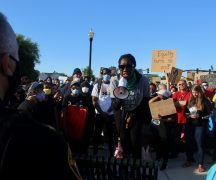Voting for the Ohio Primary Election has been extended through April 28 and will be conducted through mailed-in absentee ballots.
On Wednesday, the Ohio legislature approved a process that will continue the voting process following a postponement of the March 17 primary due to the COVID-19 pandemic. This was approved as part of a larger bill addressing several other topics related to the COVID-19 response. Gov. Mike DeWine is expected to sign the bill in short order.
Ohioans who already cast primary ballots are good to go and will have their votes counted. Those who did not vote early will now have the next month to cast absentee ballots through mail.
Here is what you need to know about voting:
- Ohioans will have to request an absentee ballot from their respective counties’ boards of elections office.
- The request form is available online. Voters can print and fill it out, then send it to their elections office. Or they can request the application form be mailed to them to be mailed back.
- Once Ohioans are approved as an absentee voter, they will receive their blank ballot in the mail.
- The filled-out ballot can be mailed back or dropped off to their board of elections office. It must be postmarked or dropped off by April 28 to count.
- You can find contact and mailing information for the 88 county boards of elections offices here.
Only voters who were eligible to vote on March 17 may cast an absentee ballot. Ohio Secretary of State Frank LaRose will be sending a postcard to all Ohioans informing them of this voting process and how they can cast ballots.
There will be no in-person voting for this primary election, though exceptions are being made in certain cases for disabled voters and those without access to the postal system.
LaRose, along with Gov. Mike DeWine and Lt. Gov. Jon Husted, had sought an in-person election date on June 2 with absentee voting through that time period.
At first, LaRose simply announced this as the primary voting date. He even issued a directive to county boards of elections to abide by his new date and plan.
After it was made clear the Ohio General Assembly had the authority to set election dates, not him, LaRose then lobbied for a bill that would’ve approved his ideas. In a recent letter to legislators, LaRose insisted the April 28 timeline would not give his office enough time to carry out an extended absentee voting system.
In the end, LaRose wasn’t given a choice. Sen. Matt Huffman, R-Lima, explained Wednesday that many communities and school districts feature local levies on the ballot and cannot afford to wait until June to learn the results.
The bill, passed unanimously in both chambers, did allocate funding for the costs to mail postcards and pre-paid ballot postage.
It is unclear how the legislature’s vote will affect pending litigation before the Ohio Supreme Court. The Ohio Democratic Party had filed legal action following the election postponement, seeking a similar process as was eventually approved by lawmakers (extended absentee voting through late April).
A spokesperson for the party declined to comment prior to the final vote.
There does remain a legal question surrounding the rights of newly-registered voters. Several voting rights groups have urged the state follow the National Voter Registration Act, which allows eligible citizens to register up until 30 days before a federal election. With this primary including the presidential primary, advocates argue an April 28 absentee voting deadline should allow for new voters to cast a ballot.
As noted, though, only those eligible to vote on the original March 17 date are being allowed to cast an absentee through April 28. It is possible this may get challenged in court.





